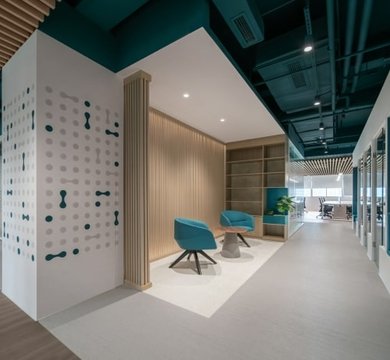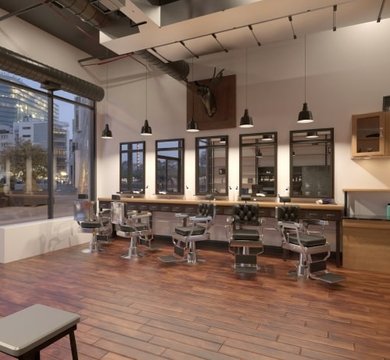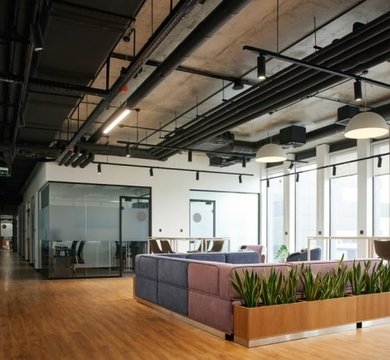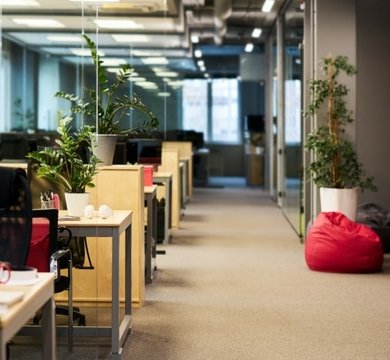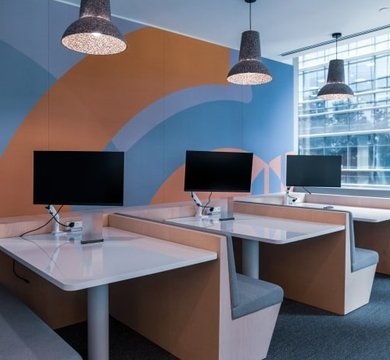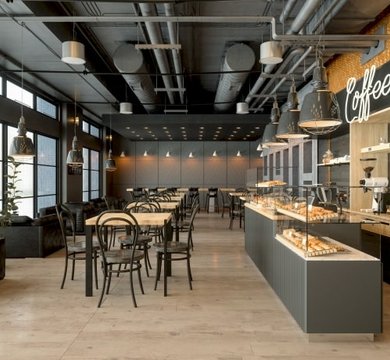Offices bring together a mix of people carrying out different roles and there’s one thing that’s rarely agreed on – the noise level. Our office interior design solutions can solve the sound conundrum, and we’re sharing some of our office acoustic solutions with you.
What Are Office Acoustics?
Acoustics relate to sound and the sense of hearing. When it comes to office acoustics, designers are concerned with how sound travels, if levels of concentration are affected and whether private conversations stay just that – private.
Office acoustics can take the form of employees’ voices, sounds from outside, ambient sounds, the noise made by equipment and the transference of sound from one area to another. If noise pollution is a nuisance, office fit out specialists examine the more technical aspects of an office, and will consider the following:
Reflection: how a sound hits a surface, and to what degree the sound is absorbed or reflected back into the space. Any sound reflected back can be distorted, amplified or even enhanced, depending on what type of surface the sound hits. Echoes and reverberations are when reflected sounds are heard after the original sound enters the ear.
Absorption: the ability of a surface to absorb sound, making the sounds in a room more palatable or less harsh. When a sound is absorbed, it travels through a material. Sound reflection is reduced when soft, padded, perforated or textured materials are specified.
Transmission: how sound waves are transferred from one space to another through a building’s elements. This includes sounds travelling between floors, through walls and via closed doors. It also includes how sound waves travel through air – a specific concern relating to open plan office acoustics.
Diffusion: sound diffusion is the art of directing sound waves in different directions and evenly spreading them through a space to lessen their impact. Sound diffusers - slices or sections of cylindrical and spherical shapes – can be positioned in a space to diffuse sound.
Office acoustic solutions are required more than ever as we build modern workspaces, embrace cutting edge interior designs, continue to work in open plan areas and adopt more agile ways of working.
Why Office Acoustics Matter
For some it’s the clickety clack of a colleague typing at speed or the microwave repeatedly going ping. For others it’s the banal chatter about last night’s TV or laughter drifting from a meeting room. Many employees find certain sounds distracting, putting them off their task and making them feel anxious. It’s why office acoustics shouldn’t be overlooked.
Employee Well-Being
Every aspect of our work environment can affect our wellbeing, noise included. When Oscar Acoustics questioned 2,000 workers, the results showed a third said their mood was negatively affected by poor office acoustics, with a quarter reporting stress induced by exceptionally high noise levels.
A secondary study by Oscar Acoustics, in which 500 senior management workers were polled, found unbearable noise levels were behind a quarter of UK workers, aged between 18 and 50, who were hesitant to go back to the office post Covid.
Workplace Productivity:
Focus and mental clarity can all be impaired when there are poor office acoustics. The extent was also revealed by Oscar Acoustics. It found 60% of office workers were unable to concentrate and produced sub-par work due to loud workspaces.
Communication
Communication takes many forms in the office, including face-to-face meetings, telephone calls and video conferencing. If the sound is distorted, muted or so poor that people can’t understand what’s being said, there is room for misinterpretation. Conversely, communication being heard at a high volume can also disturb those in the vicinity.
Office Acoustic Solutions
Sound Absorption
If egg boxes are the first thing that springs to mind when you think about office acoustic solutions, it’s time to rethink. Sound absorption has thankfully become more sophisticated. Many materials have been engineered to absorb sound. These include cork, gypsum board and metal foams, which can be used to create dividers and partitions, or even used to line walls and ceilings. Even our iconic wooden slat feature walls and ceilings can be specified to have maximum sound absorbing properties.
It’s also possible to absorb sound with fabric and textiles. The most obvious is to use carpet, which will absorb the sound of footsteps. At our project No. 5 The Heights, we used full length, heavy drapes that can be pulled round to create a meeting space – creating temporary visual and audio privacy.
Soundproofing
It’s important to know that sound absorption and soundproofing are two different things. It is very difficult to fully soundproof a room as sound can enter through the tiniest of gaps and travel at different frequencies – higher pitch sounds are very hard to block out. True soundproofing involves dampening, adding objects of mass and decoupling, as well as sound absorption.
Furniture and Layout
If your burning question is ‘how can I improve my office acoustics?’, you’ll need to start with your workplace layout. Throwing everyone in together may create a cacophony of noise and you may already know that employees are irritated by mobile phones constantly going off or office banter.
MPL will zone workplaces so there are distinct areas where office acoustics are controlled. Collaboration areas can be positioned away from small desk clusters, and there will always be a balance of enclosed private offices and open plan spaces. Sound absorbing furniture and accessories will also help where noise is an issue; sofas, upholstered arm chairs, rugs and padded office chairs all play their part in office acoustics.
Acoustic Clouds and Baffles
Acoustic clouds and baffles – usually suspended from the ceiling - can provide an acoustic solution for those who want an exposed plenum ceiling but need to dampen noise and minimise sound interference. Acoustic clouds can be made from 100% sheep’s wool and waste wood fibre for a sustainable approach to noise absorption. Office ceiling baffles act in a similar way to acoustic clouds but tend to be hung vertically rather than horizontally. Baffles are usually rectangular in shape but it is possible to specify designer ‘wave’ options.
Technology Integration
Technology also has a role to play in office acoustics. In its simplest form, active noise cancellation (ANC) sees microphones positioned to detect unwanted noise and a loudspeaker used to play an opposite sound wave to mitigate the distracting din. The sound of whirring servers, machinery and manufacturing can be effectively cancelled out through ANC alone, although there is an increasing requirement for this type of technology in office settings.
AI-powered noise cancellation technology is also useful where video conferencing needs to take place but there are poor office acoustics, such as in busy open plan offices or meeting rooms in close proximity to a kitchen or neighbouring business. New advancements can help filter out distracting background noise from the audio output, which allows people to hear conversations more clearly.
Open Plan Office Acoustics
While the open plan office is convivial and creative, it also presents challenges in terms of noise pollution and audio distractions.
Challenges of Open Plan Offices
The nature of an open plan office is to have nothing more than a set of perimeter walls. This style of cavernous space creates all sorts of acoustic issues, including sound reflection and reverberation, and marked sound transference. While a buzzy atmosphere with chatter and background noise might suit a sales environment, it’s not practical for highly focused tasks where quiet is required.
Enhancing Acoustics in Open Plan Offices
If you want to keep the essence of open plan working, there are ways to reduce noise transference. Acoustic screens, either floor or desk mounted, will limit the flow of sound between colleagues and departments. Full height glass partitions are another way to keep workplaces light and connected but acoustic-friendly, while the position of storage units and plants can sometimes be enough to take the edge off travelling sounds.
If collaboration is a key reason for having people in the office, break out zones can be included in more outlying areas of open plan offices. Alternatively, pods and padded booths are a great addition to open plan areas.
Hybrid Habits & Office Acoustics
Now more of us have adopted hybrid working patterns, habits are transferring from home set ups to the office. Eating noisy lunches and participating in Zoom calls at our desks has become the norm in many workplaces, which can be super distracting for others. There’s also a line of thinking that hybrid working means focusing in peace at home, while the office is for collaboration, networking and fun.
On the flipside, many employees had to work in busy home environments during the pandemic (think kids, washing machines and pets) and now seek refuge in a quiet, professional office.
Office acoustics solutions should address all scenarios, balancing the needs of those who work best in vibrant offices and those coming into work to take part in lively brainstorming sessions, with those who need peace to be productive.
Conclusion
Ignoring office acoustics will be at the detriment of your company’s productivity, output and wellbeing. There are five golden rules to creating a workplace where acoustics are successfully controlled. If you consider the following, you’ll be on the right track:-
- Realise that some employees will actively seek out a professional office environment for peace and fewer distractions.
- Acknowledge that some design features, such as exposed plenum ceilings and polished concrete floors, present acoustic problems that may need solving.
- Establish if you want to stop sound from getting in, sound from leaking out or sound from travelling.
- Use the space planning and specification stages of an office refit to request acoustic materials and strategic furniture placement.
- Include private meeting rooms and quiet zones in redesigned offices





